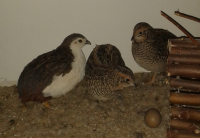Hi All! 
This Wednesday, I have a good friend willing to drive me out to a farm in the East to go and pick up some Buttons! This farm is known for the love and attention they put into their birds...
I'm looking to become a hobby-breeder to potentially sell chicks/adults to others in the Seattle area to spread the Button fun I will be a first-time owner, but I've done all the research I need. I just have some questions that I couldn't find much meat on.
I will be a first-time owner, but I've done all the research I need. I just have some questions that I couldn't find much meat on.
Essentially, my goal is to sell gorgeous chicks as pets to locals. I want my chicks to be calm and friendly, and I want to try my best to produce as many neutral-colored chicks (silver, tux, splash, white) as possible.

This Wednesday, I have a good friend willing to drive me out to a farm in the East to go and pick up some Buttons! This farm is known for the love and attention they put into their birds...
I'm looking to become a hobby-breeder to potentially sell chicks/adults to others in the Seattle area to spread the Button fun
 I will be a first-time owner, but I've done all the research I need. I just have some questions that I couldn't find much meat on.
I will be a first-time owner, but I've done all the research I need. I just have some questions that I couldn't find much meat on.Essentially, my goal is to sell gorgeous chicks as pets to locals. I want my chicks to be calm and friendly, and I want to try my best to produce as many neutral-colored chicks (silver, tux, splash, white) as possible.
- I want to try and stick with colors that are more like silver, tuxedo, splash, etc. I think I'm going to pick up a silver and a splash for parents...and try to get handsome chicks from them. Is there any advice you all have about selective breeding? I tried to find some more info specifically about buttons to no avail! The only thing I heard was to avoid breeding two golden pearl together...as it makes for weak chicks. Not sure about the accuracy, but I would avoid anything that puts the chicks lives in danger!
- Are there any things I should look for when I pick out the parents? Any things I should avoid?
- How many pairs should I get? One or two? I was thinking since I was going to sell the chicks, I only need one pair...but if I want to sell them as breeding pairs, I would have to have blood from a different pool to give them away as a pair. What makes the most sense? I guess if I want to sell them in pairs/trios, they will have to at least have the one male from a different gene pool...unless I only sold the hens together. But then I wouldn't know what to do with the males?





 I have gotten Cinnamons and a Silver Tuxedo from my quail along with other Red Breasted and Blue Faced quail.
I have gotten Cinnamons and a Silver Tuxedo from my quail along with other Red Breasted and Blue Faced quail.



